#chinese turnip
Photo
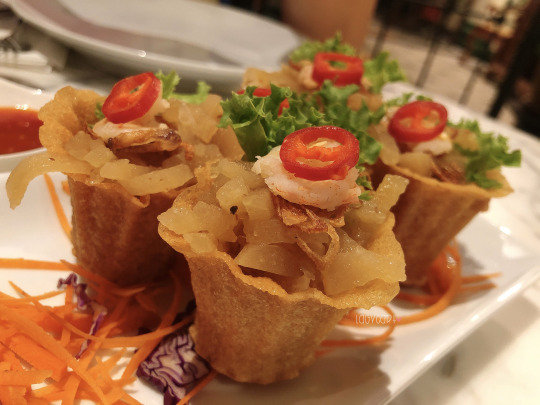
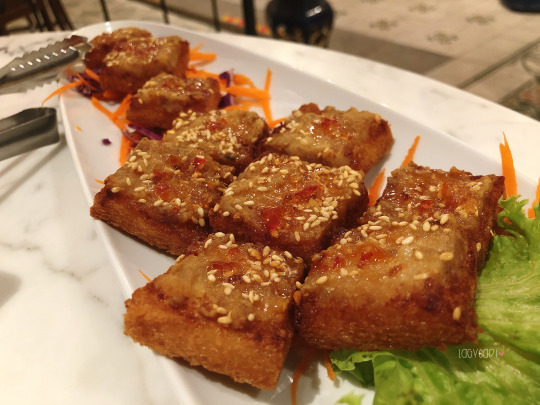
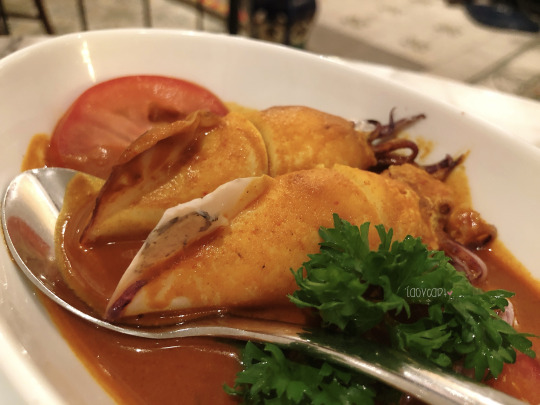
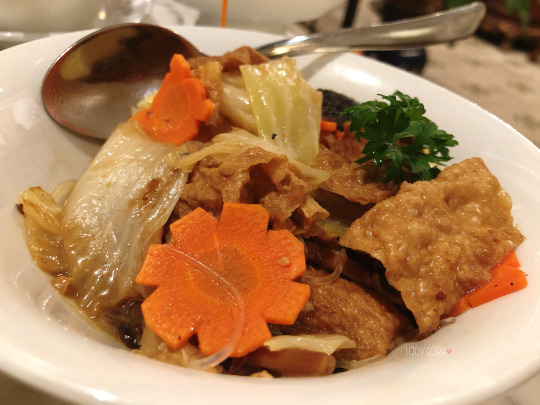
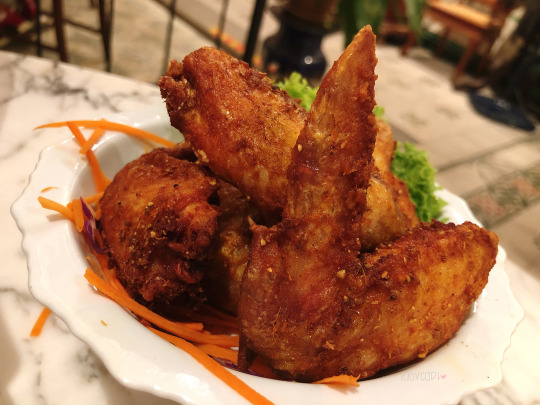
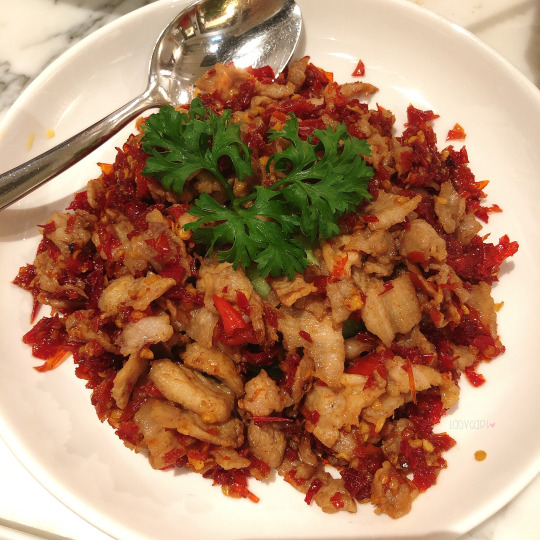
peranakan mansion 僑生府, melaka.
this was the restaurant we couldn’t visit on the first night, hence we made a reservation and went to have dinner on the second night instead. the restaurant is newly opened this year, and the interior deco of the traditional long house is really really beautiful, very instagrammable every corner.
their menu also have quite a variety of dishes, and also some of the dishes are not in the menu but the staff may let you know about it when you make your order, so do enquire if you are interested. we ended up with six dishes because everything sounds and looks yummy. XD
for starters, there’s the signature pie tee which is shredded chinese turnip inside a crispy shell, very unique nyonya starter that you must try with the chili sauce. also ordered the roti babi, which is not listed in the menu, minced meat on top of toast, very crispy and tasty appetizer, definitely good for sharing.
then there’s babi cili garam (pork belly with salted chili), nyonya chap cai (mixed vegetables), inchi kabin (friend chicken wings) and sotong sumbat (stuffed squid) to go with rice. all the dishes are really really yummy and so flavorful and appetizing. i love the crispy wings a lot, very flavorful and addictive. the pork belly looks spicy but it’s not, goes perfectly with white rice. the squid is cooked just nice, and the curry sauce is flavorful. the mixed vegetables are crunchy and enjoyable too.
we were completely stuffed and very satisfied with the meal, didn’t expect to eat so much but just could not resist, especially seeing how other customers enjoy their food so well too. the staff here are also attentive and friendly, so we get good service and great attention during our dinner. definitely highly recommended to visit this restaurant to try out some of the delicious nyonya dishes that melaka has to offer, reservation is almost necessary to prevent any disappointment, and remember to take lots of photos.
#food#nyonya#peranakan mansion#melaka#malacca#newly opened#ambiance#interior#traditional#long house#instaworthy#instagrammable#signature#pie tee#roti babi#toast#minced meat#chinese turnip#appetizers#starters#specials#sotong sumbat#mixed vegetables#chap cai#inchi kabin#friend chicken wings#pork belly#salted chili#babi cili garam#flavorful
5 notes
·
View notes
Text
lunar new year foods

In the last Chinese New Year post we talked about some of the traditions that accompany the new year's celebrations. We did not, by any means, cover all of them. A quarter of the world's population celebrate the Spring Festival and that's a lot of room for a lot of different traditions. For this post, I'd like to talk about some of the dishes eaten for the festival that have meanings that go a little deeper than simply being tasty, though they are that as well. I am not going to be able to mention all of them so I hope that everyone feels absolutely free to include them in the notes, tags or reblogs.
One can never have too many delicious food suggestions.
Let's start off with a familiar one. In many parts of Northern China, dumplings are front and center when it comes to meals. This is because the Chinese symbol for dumpling 饺子 sounds like 交子. 交 means 'exchange' and 子 is 'midnight'. So this play on word-sounds means to exchange the old with the new at midnight. In some areas the stuffing in the dumplings needs to be egg for prosperity in the coming year. The dumpling itself is reminiscent of silver ingots and the egg therefor adds gold to things as well. Alternately, you can add meat and bamboo strips which will make sure that everything you will need in the coming year will come your way. Don't use anything pickled however as this might lead to a difficult future. And lastly, don't forget to add a coin or a long thread to one of the dumplings. Whoever is lucky enough to find the coin will have good fortune and the thread is for long life (as long as no one chokes on it!).
Don't forget the fish either. The symbol for fish sounds a great deal like the symbol for 'extra'. Make sure to eat the middle of the fish but not the head or the tail. This will help you finish everything you start, from 'head to toe (well, tail)' so to speak. Also you shouldn't eat the whole fish in one sitting. Stretch it out into two meals so that your prosperity and extra will stretch out for the whole year as well. Have a business you want to thrive? Add red peppers to the cooking fish. Not only is red a lucky color, the spiciness of the meal will lead to a lively future for your business as well.
Nian gao is a must. Originally reserved for the gods and ancestors as offerings, these rice cakes have since become a tasty treat for everyone. Gao sounds like the word for 'higher'. Hence, if you want to go higher in the new year, you've got a very good reason to tuck into these delicious cakes.
You also want to keep an eye out for turnip cakes. They're made of shredded Chinese radish. 'Radish' sounds similar to 'good luck and fortune' so this is a tasty way to bring exactly that into the new year. These cakes are especially popular on the seventh day of the festival as a reminder that the goddess Nu Wa created humans on the seventh day.
Don't turn up your nose at unprepared food either. Oranges, kumquats and tangerines have a golden color that is sure to bring in prosperity in the coming year. Peaches will bring longevity and health. Muskmelon and grapefruit symbolize family and hope. And if you want a large family, start eating pomegranates.

#chinese new year#lunar new year#spring festival#year of the dragon#dumplings#fish#nian gao#turnip cake#folklore#superstition#word play
12 notes
·
View notes
Text

Sanbeiji Tofu - Inspired by Traditional Southern Chinese Dish (Vegan)
#vegan#appetizer#chinese cuisine#east asian cuisine#tofu#sanbeiji chicken#carrots#sweet potatoes#turnips#sambal oelek#thai basil#soy sauce#cornstarch#garlic#sake#sesame oil#coconut sugar
35 notes
·
View notes
Text
Happy Chinese New Year's Eve! Annual CNY lunch tradition: Mom's making fried turnip cake! My favorite food. 😋 Sound on for that sizzle! // (c) Jenny Lam 2024
#food#turnip cake#dim sum#chinese food#cny#cny2024#chinese new year#year of the dragon#home#chinese#chinese american#chinese culture#lunar new year#happy chinese new year#happy lunar new year#video#satisfying#oddly satisfying
7 notes
·
View notes
Text

Chinese Turnip Cake "Lo Bak Gao" for Lunar New Years!!! 🎊🎋🧧
#chinese turnip cake#lo bak gao#lunar new year#radish cake#daikon cake#chinese food#chinese recipes#lunar new year recipes#lunar new year food#chinese new year#chinese new year recipes#chinese new year foods#daikon#food#foodies#food pics#food blog#sikfan kitchen#year of the dragon
3 notes
·
View notes
Photo

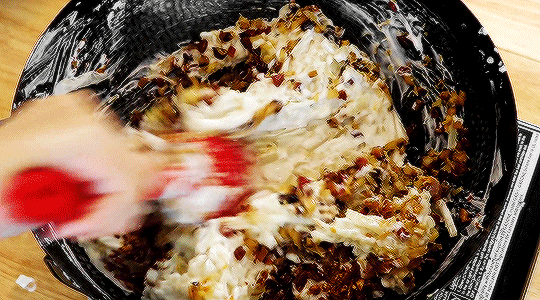


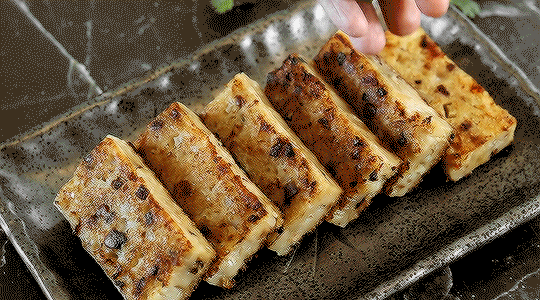
turnip cake recipe
#foodedit#food#food gifs#foodcore#userbbelcher#recipes#chinese cuisine#chinese recipes#chinese turnip cake#turnip#mine#gifs#youtube#souped up recipes
37 notes
·
View notes
Text
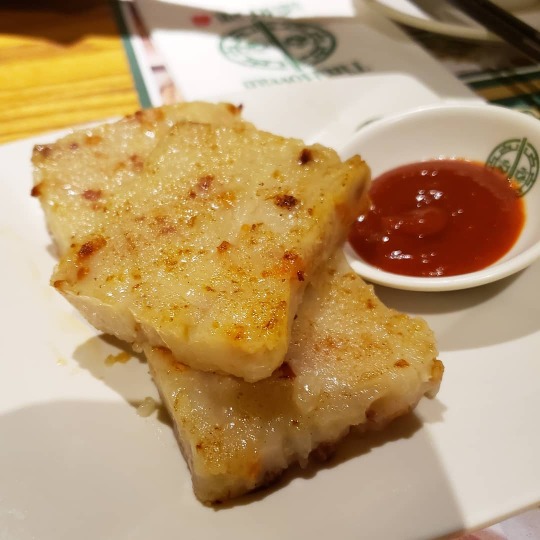
🥕some pan-fried radish cake from 📍Tim Ho Wan on 4th avenue!
🥟 Radish cake, also known as lo bak go, has always been one of my favorite dim sum dishes. The chili sauce was slightly more bitter than what I'm used to, but the radish cakes were exceptionally well made!
#dumpling#radish#turnip#cake#lobakgo#dimsum#蘿蔔糕#點心#添好運#newyork#newyorkcity#ny#nyc#4thave#food#foodphotography#foodstagram#college#chinese#asian#tim ho wan#new york#new york city#Food I Bought
3 notes
·
View notes
Text

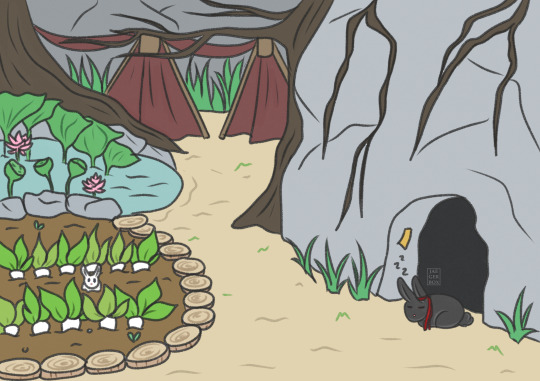
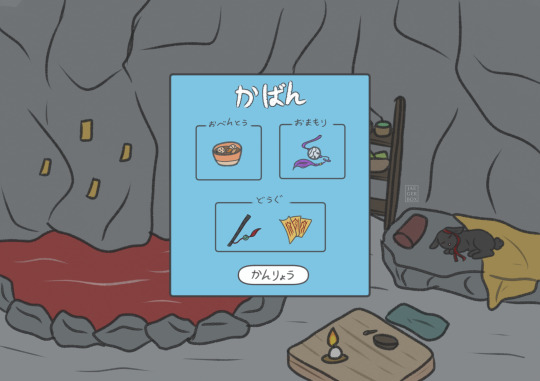

Tabikaeru x mdzs crossover
#my art#mdzs#tabikaeru#mo dao zu shi#spot a-yuan in the turnip patch#i know i wrote wwx's name in simplified chinese rather than traditional ^^;;#魔道祖師#旅かえる
10 notes
·
View notes
Text
WHY IS LONDON DISAPPEARING? The Wandering Turnip
youtube
A question. #TalkTV, #GBNews #DailyMailuk #Guardian #BBC Rishi Sunak, all make noise about Immigration. They have no room. London is completely overrun and crowded due to those horrible immigrants. Here is a guy named the Wandering Turnip, UK. He has a video series, showing just how completely abandoned London and the wider UK is. I looked up some numbers. In the UK, they have:
Over 1 million empty residential dwellings
Approx 261,000 are long-term residential
Approx 58,000 empty retail spaces
3,000 abandoned Medieval towns
At least 10 abandoned seaside towns!
There's even a town that regularly floods the houses and they still won't lower the sale prices
So...where are all the immigrants going, besides the local McDonald's and a motel in the suburbs? They're not attacking anything. Soho, empty, Blackpool, empty.
#WHY IS LONDON DISAPEARING?#The Wandering Turnip#Britain is dead!#Russian Rubles Gone#Chinese Yuan Gone#Only Idiots Left In The Building#Youtube
0 notes
Text
lessss go, lo bak goooooo
0 notes
Text

Turnip Cake, double cooked to perfection
Ingredients (for 3 small cakes):
1.2kg Daikon radish
2 cured Chinese sausages
30g dried shrimp
200g rice flour
70g wheat flour
1tsp salt
2tsp chicken powder
1tsp sugar
1/2 tsp pepper
Method:
Soak the dried shrimps for at least 1h
Boil the grease and wax off the sausages, then peel and finely chop.
Stir fry the shrimps, setting aside their water, until aromatic.
Add in the sausages until aromatic, then set aside.
Peel the radish until you see the netting, keeping about 80%.
Cut into chuncks, then grate it into a bowl.
Using your hands, pick up the solid pieces of radish, squeezing the juice out of them back into the bowl, setting the dried radish aside.
Add the flours and shrimp water into the radish juice, and mix until it becomes a batter.
Sautee the dry radish in a wok, and season with the salt, pepper, sugar, and chicken powder.
Add 3/4 of the meat and shrimp, and continue cooking.
Set to low heat, and add the batter in.
Cook until the dough has reduced and become sticky.
Place in oiled trays, and steam for 45 mins or until an inserted chopstick comes out clean.
Cut into pieces and stir fry, serve with the remaining sausage and shrimp on top. Hoisin or sweet chilli sauce pairs well.
Do make sure to dry out the radish well during the draining and cooking process, as a soggy cake is hard to cut and fry up. As it is steamed, it will absorb some moisture back too.


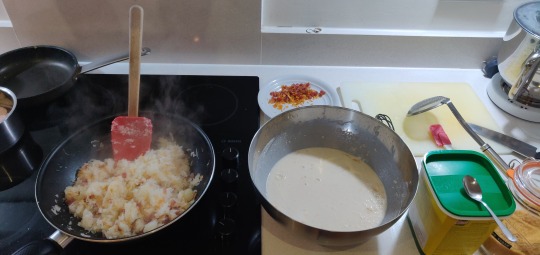
0 notes
Text
Why We Can't Have Medieval Food
I noted in a previous post that I'd "expand on my thinking on efforts to reproduce period food and how we’re just never going to know if we have it right or not." Well, now I have 2am sleep?-never-heard-of-it insomnia, so let's go.
At the fundamental level, this is the idea that you can't step in the same river twice. You can put your foot down at the same point in space, and it'll go into water, but that's different water, and the bed of the river has inevitably changed, even a little, from the last time you did so.
Our ingredients have changed. This is not just because we can't get the fat from fat-tailed sheep in Ireland, or silphium at all anywhere, although both of those are true. But the aubergine you buy today is markedly different to the aubergine that was available even 40 years ago. You no longer need to salt aubergine slices and draw out the bitter fluids, which was necessary for pretty much all of the thing's existence before (except in those cultures that liked the bitter taste). The bitterness has been bred out of them. And the old bitter aubergine is gone. Possibly there are a few plants of it preserved in some archive garden, or a seed bank, or something, but I can't get to those.
We don't really have a good idea of the plant called worts in medieval English recipes. I mean, we know (or we're fairly sure) it was brassica oleracea. But that one species has cultivars as distinct as cabbage, broccoli, cauliflower, kale, Brussels sprouts, collard greens, Savoy cabbage, kohlrabi, and gai lan (list swiped from Wikipedia). And even within "cabbage" or "kale", you have literally dozens of varieties. If you plant the seeds from a brassica, unless you've been moderately careful with pollination, you won't get the same plant as the seeds are from. You can crossbreed brassicas just by planting them near each other and letting them flower. And of course there is no way to determine what varietal any medieval village had, a very high likelihood that it was different to the village next door, and an exceedingly high chance that that varietal no longer exists. Further, it only ever existed for a few tens of years - before it went on cross-breeding into something different. So our access to medieval worts (or indeed, cabbage, kale, etc) is just non-existant.
Some other species within the brassica genus are as varied. Brassica rapa includes oilseed rape, field mustard, turnip, Chinese cabbage, and pak choi.
We have an off-chance, as it happens, of getting almost the same kind of apple as some medieval varieties, because apples can only be reproduced for orchard use by grafting, which is essentially cloning. Identification through paintings, DNA analysis, and archaeobotany sometimes let us pin down exactly which apple was there. But the conditions under which we grow those apples are probably not the same as the medieval orchard. Were they thinned? When were they harvested? How were they stored? And apples are pretty much the best case.
Medieval wheat was practically a different plant. It was far pickier about where it would grow, and frequently produced 2-4 grains per stalk. A really good year had 6-8. In modern conditions, any wheat variety with less than 30 grains per stalk would be considered a flop.
Meats are worse. Selective breeding in the last century has absolutely and completely changed every single species of livestock, and if you follow that back another five centuries, some of them would be almost unrecognisable. Even our heritage breeds are mostly only about 200 years old.
Cheese, well. Cheese is dependent on very specific bacteria, and there are plenty of conditions where the resulting cheese is different depending on whether it was stored at the back or front of the cave. Yogurts, quarks, skyrs, etc, are also live cultures, and almost certainly vary massively. (I have a theory about British cheese here, too, which I'll expand on in a future post)
So, even before you go near the different cooking conditions (wood, burnables like camel and cow dung, smoke, the material and condition of cooking pots), we just can't say with any reliability that the food we're making now is anything like medieval people produced from the same recipe. We can't even say that with much reliability over a century.
Under very controlled conditions, you could make an argument for very specific dishes. If you track down a wild mountain sheep in Afghanistan, and use water from a local spring, and salt from some local salt mine, then you can make a case that you can produce something fairly close to the original ma wa milh, the water-and-salt stew that forms the most basic dish in Arabic cookery. But once you start introducing domestic livestock, vegetables, or even water from newer wells, you're now adrift.
It is possible that some dishes taste exactly the same, by coincidence. But we can't determine that. We can't compare the taste of a dish from five years ago, let alone five hundred, because we're only just getting to a state where we can "record" a taste accurately. Otherwise it's memory and chance.
We've got to be at peace with this. We can put in the best efforts we can, and produce things that are, in spirit, like the medieval dishes we're reading about. But that's as good as it gets.
#medieval cookery#medieval cooking#food history#historical cookery#historical cuisine#medieval arabic cookery#horticulture#genetics
1K notes
·
View notes
Text
Try to learn about the old foods
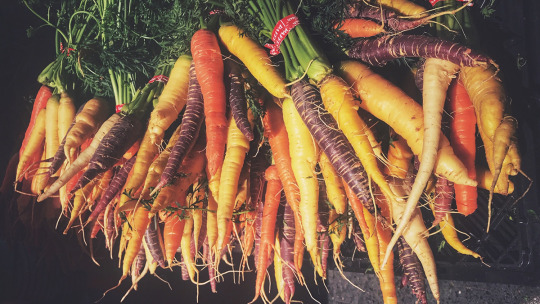
I have most recently started to meal prep, with making a lot of foods and putting them in the freezer. This ended up allowing me to buy the foods in bulk from the local market. And, well... This allowed me to eat some of the foods that the supermarket does not have.
We do have a bit of a problem. And that problem mostly is that we got our food kinda messed up. Because people have lost the connection to the food they eat. But also because of colonialism.
The big thing that happened is, that we lost contact with most local foods. No matter where I go in the "first world nations"... The foods offered to me in the supermarkets are the same - and they also look the same.
This means that a lot of people have no real idea, what foods came from where in the world - but also do not know half of the foods that originated with where they are from, because they are not easily available.

Tomatoes are an example. Not only did historical tomatoes look and taste very differently from the tomatoes we eat today, but obviously... they came from the Americas. So they are not a food that originated with Europe and was not widely available in Europe until the 1600s. While, yes, the first tomates came here more than a hundred years earlier... it took a while for them to catch on.

This is parsnip. Another root vegetable that was commonly eaten in Europe for most of history. It has a more intensive taste than the usual carrot - but is also not that different from it, when it comes to consistency and how it is going to cook.

This is fennel. You might know fennel seeds as a spice or something you might drink as a tea. But the rest of the plant is edible, too, and a surprisingly strong flavored vegetable. It also is very crunchy and makes a really great addition to salads. But it is often not really sold in many places.

This is the Jerusalem Artichoke, another vegetable that originates within the Americas. To be exact, this is the root of a kind of sunflower. It got its name for being very similar in taste and tecture to the Artichoke. I honestly do not know, though, why it is called "Jerusalem Artichoke", because it does not have anything to do with Jerusalem.
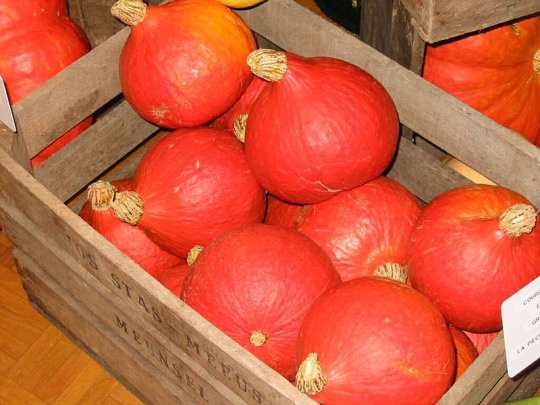
The Potimarron is a kind of squash that - like basically all other forms of squash - originates in the Americas as well. It has a very nutty flavor. In Europe it was very popular in France for a long while, hence the french name. It has tons of meat and really makes for great stews!

This is a rutabaga, which originates from somewhere in northern Europe. We do not really know from where. All we know is, that it was a Swedish botanist who cultivates the form we still eat to this day in the 1620s. Which is why it is also called the "Swedish turnip". It does taste like a more bitter carrot, but makes really good addition to stews or can be served stamped.
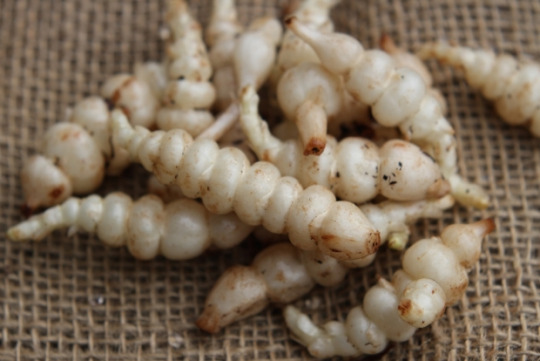
This is the Chinese Artichoke and another root vegetable, that as the name suggest originates from China. It was cultivates in China in the late medieval period and has later made its way to Europe, especially France. It has a really sweet and nutty taste and can be eaten raw or in salads. Though there are dishes mashing the vegetable, too.

These are tigernuts, a vegetable that has been around forever. It originates in southern Europe, southern Asia and northern Africa. It is a dried fruit, with a sweet and earthy taste and it is known a lot in Spanish cuisine, but also in the cuisine of southern Asia.

Yacon is a root vegetable that originates with Peru, where it is still eaten, while the rest of the world mostly forgot about it. Well, except Japan, where it is currently getting more and more popular. It is a vegetable, but it has a very fruity taste.
I could now go on and name more vegetables from all around the world that were once grown and fed people, but got forgotten more and more in favor of the very limited diet made up of potatoes, corn, potatoes, peppers, cucumber, onion and tomatoes, that is basically what you will get to eat in most places.
And... Well, the thing about it is that... It is not really a good thing that we grow the same stuff everywhere. It is not good for us and it is not good for the environment. It is not good for those foods, either.
I really wish people would try and eat more of the stuff that originates with their region. And that they would eat the not-so-perfect looking foods as well. Because it is gonna be more sustainable in the end.
#solarpunk#food#vegetables#fruits#farming#agriculture#history#food history#sustainable living#sustainability#colonialism
325 notes
·
View notes
Text

Brassica, in case you didn't know, is actually one plant that has been cultivated for different uses creating a wide variety of vegetables to love.
Seriously what can't brassica do?
(reblog for bigger sample size, if you don't mind)
49 notes
·
View notes
Text
youtube
Chinese Turnip Cake | Lo Bak Go 蘿蔔糕
#Chinese turnip cake#lo bak go#蘿蔔糕#dim sum#cantonese food#chinese food#daikon#radish cakes#turnip cakes#chinese cooking#canto#cantonese#yum cha#food#foodie#food pic#food video#food blog#cooking#homecooking#recipe#youtube#hong kong food#Youtube
4 notes
·
View notes
Text
Duoyinzi (多音字) That Have Betrayed Me on a Personal Level
This is a continuation of my 多音字 series. You can view the last post here. Today I’m focusing specifically on 20 characters that left me very surprised when I found out they have other pronunciations!
For some of the more basic characters, I’m not including sample vocab words this time. But I have added some lively commentary :)
1)喝
喝 hē - to drink
喝 hè - to shout
喝彩 hècǎi - to acclaim / to cheer
Of course we all know 喝 hē ask in to drink. I very recently encountered the word 喝彩, and I assumed it was pronounced hēcǎi. Nope. I was so very wrong.
2)上
上 shàng - on top / upon / above / upper / previous / first (of multiple parts) / to climb / to get onto / to go up / to attend (class or university)
上 shǎng - used in 上声
上声 | 上聲 shǎngshēng - falling and rising tone / third tone in modern Mandarin
上 shàng is one of the first characters many of us learned. So you can imagine how betrayed I felt when I learned that it can also be pronounced shǎng. Thankfully, this seems to be isolated to the word 上声.
3)大
大 dà - big / huge / large / major / great / wide / deep / older (than) / oldest / eldest / greatly / very much / (dialect) father / father's elder or younger brother
大 dài - see 大夫
大夫 dàifu - doctor / physician
This was another huge betrayal. You see, I started learning Chinese about 15 years ago. 大 was likely one of the first characters I ever learned, and I just never imagined in could be pronounced as anything but dà! Has everything been a lie?
4)哪
哪 nǎ - how / which
哪 né - used in 哪吒 / Taiwan pr. nuó
哪吒 Nézhā - Nezha, protection deity / Taiwan pr. nuózhà
When I saw Nezha written in Chinese for the first time, I was very confused. I just didn’t get how the né sound could be my old friend 哪. And apparently in Taiwan it has a whole different pronunciation. Ugh!
5)降
降 jiàng - to drop / to fall / to come down / to descend
降低 jiàngdī - to reduce / to lower / to bring down
降落 jiàngluò - to descend / to land
下降 xiàjiàng - to decline / to drop / to fall / to go down / to decrease
降 xiáng - to surrender / to capitulate / to subdue / to tame
投降 tóuxiáng - to surrender / surrender
I was really convinced that I was just hearing things wrong with this character. I first heard the word 投降 in Chinese songs, so I thought I was mishearing the lyrics. Nope—降 is a 多音字.
6)济 | 濟
济 | 濟 jì - to cross a river / to aid or relieve / to be of help
经济 | 經濟 jīngjì - economy / economic
济 | 濟 jǐ - used in place names associated with the Ji River 济水 or in 济济 / surname Ji
济南 | 濟南 Jǐnán - Jinan, subprovincial city and capital of Shandong province in northeast China
I was really surprised to learn that I don’t know many words with the character 济. It’s pretty much just 经济. The only other time I’ve ever actually seen the character 济 is in the name of the city of Jinan (济南).
7)混
混 hùn - to mix / to mingle / muddled / to drift along / to muddle along / to pass for / to get along with sb / thoughtless / reckless
混合 hùnhé - to mix / to blend / hybrid / composite
混乱 | 混亂 hùnluàn - confusion / chaos / disorder
混 hún - confused / dirty / to mix / muddy / variant of 浑
混蛋 húndàn - scoundrel / bastard / hoodlum / wretch
I was very surprised to see that 混蛋 can be pronounced húndàn because I don’t think I’ve ever heard 混 as hún before. I think hùndàn sounds better, and luckily it’s also a valid pronunciation. Two fourth tones are better to yell.
8)蔓
蔓 màn - creeper / to spread
蔓延 mànyán - to extend / to spread
蔓 wàn - tendrilled vine
藤蔓 téngwàn - vine / also pr. téngmàn
蔓 mán - turnip / Brassica campestris
蔓菁 mánjing - turnip / wild cabbage
Until recently, the only word I knew with this character was 蔓延. Then I learned 藤蔓 via this performance. Apparently 藤蔓 can be téngwàn or téngmàn, but I have only ever heard téngwàn. 蔓 can also be pronounced mán in 蔓菁 mánjing, which is some sort of turnip. I don’t like turnips.
9)佛 | 彿
佛 fó - Buddha / Buddhism / abbr. for 佛陀
佛教 Fójiào - Buddhism
佛系 fóxì - chill about everything (typically used to describe young people who don't buy into aspirational society)
佛 | 彿 fú - seemingly
仿佛 | 彷彿 fǎngfú - to seem / as if / alike / similar
I have known both the fó and fú pronunciations for a while, but I never realized they were written the same. However, 仿佛的佛 can be written differently in traditional characters (彷彿), so I guess that avoids any confusion.
10)压 | 壓
压 | 壓 yā - to press / to push down / to keep under (control) / pressure
压力 | 壓力 yālì - pressure
压抑 | 壓抑 yāyì - to constrain or repress emotions / oppressive / stifling / depressing / repression
压迫 | 壓迫 yāpò - to oppress / to repress / to constrict / oppression / stress (physics)
压 | 壓 yà - see 压根儿
压根 | 壓根 yàgēn - from the start / absolutely / entirely / simply
I recently started watching the show 《摇滚狂花》, and the characters have been using the word 压根 a lot. I was literally backing up and replaying lines to confirm that I was actually hearing yà and not yā, which is the more common pronunciation that I am more familiar with. It appears that the yà pronunciation is actually only used in 压根.
11)片
片 piàn - thin piece / flake / a slice / film / TV play / to slice / to carve thin / partial / incomplete / one-sided / classifier for slices, tablets, tract of land, area of water / classifier for CDs, movies, DVDs etc / used with numeral 一: classifier for scenario, scene, feeling, atmosphere, sound etc.
片面 piànmiàn - unilateral / one-sided
片刻 piànkè - short period of time / a moment
片断 piànduàn - section / fragment / segment
片 piān - disk / sheet
片子 piānzi - film / movie / film reel / phonograph record / X-ray image / also pr. piànzi
照片 zhàopiān - photograph / picture / also pr. zhàopiàn
影片 yǐngpiān - film / movie / also pr. yǐngpiàn
Some words like 影片 and 照片 seem to be acceptable with either pronunciation of 片. Now that I think about it, I’m pretty sure I have heard zhàopiān before—usually with 儿化音. From what I’ve gleaned from various dictionaries, the piān pronunciation is more 口语 and not used in Taiwan.
12)豁
豁 huō - opening / stake all / sacrifice / crack / slit
豁出去 huōchuqu - to throw caution to the wind / to press one's luck / to go for broke
豁 huò - clear / open / exempt (from) / liberal-minded
豁然开朗 | 豁然開朗 huòránkāilǎng - suddenly opens up to a wide panorama (idiom); to come to a wide clearing / fig. everything becomes clear at once / to achieve speedy enlightenment
I was familiar with this character from the term 豁出去. Then as part of my chengyu challenge, I learned 豁然开朗. Here, 豁 is pronounced huò instead. My reaction to this discovery was something along the lines of: oh great, another 多音字!
13)将 | 將
将 | 將 jiāng - will / shall / to use / to take / to checkmate / just a short while ago / (introduces object of main verb, used in the same way as 把)
将来 | 將來 jiānglái - in the future / future / the future
即将 | 即將 jíjiāng - on the eve of / to be about to / to be on the verge of
将近 | 將近 jiāngjìn - almost / nearly / close to
将 | 將 jiàng - general / commander-in-chief (military) / king (chess piece) / to command / to lead
麻将 | 麻將 májiàng - mahjong
唱将 | 唱將 chàngjiàng - top singer
I should have realized this was a 多音字 because of course I know 麻将, where 将 is jiàng. But I never really thought about it, so I didn’t realize 将 was a 多音字 until I learned 唱将 while watching 《蒙面唱将猜猜猜》, China’s version of The Masked Singer. Apparently these is also a qiāng pronunciation of this character, but I have never encountered it before.
14)丧 | 喪
丧 | 喪 sàng - to lose sth abstract but important (courage, authority, one's life etc) / to be bereaved of (one's spouse etc) / to die / disappointed / discouraged
沮丧 | 沮喪 jǔsàng - dispirited / dejected / dismayed
丧 | 喪 sāng - mourning / funeral / (old) corpse
丧事 | 喪失 sāngshì - funeral arrangements
In my experience, the most common word containing this character is 沮丧. Then in one of my readings for Chinese class, I learned 丧事 sāngshì. Unfortunately, I always forget that it’s supposed to be sāng and end up saying sàng no matter the word.
15)给 | 給
给 | 給 gěi - to / for / for the benefit of / to give / to allow / to do sth (for sb) / (grammatical equivalent of 被) / (grammatical equivalent of 把) / (sentence intensifier)
给 | 給 jǐ - to supply / to provide
给予 | 給予 jǐyǔ - to accord / to give / to show (respect)
I was really surprised when I first saw the word 给予 and learned that it’s pronounced jǐyǔ. But here’s the truth: I hear people say gěiyǔ all the time. It’s still good to know about the jǐyǔ pronunciation though.
16)恶 | 惡
恶 | 惡 è - evil / fierce / vicious / ugly / coarse / to harm
恶劣 | 惡劣 èliè - vile / nasty / of very poor quality
恶意 | 惡意 èyì - malice / evil intention
邪恶 | 邪惡 xié'è - sinister / vicious / wicked / evil
恶 | 惡 ě - used in 恶心
恶心 | 惡心 ěxīn - nausea / to feel sick / disgust / nauseating / to embarrass (deliberately)
恶 | 惡 wù - to hate / to loathe / ashamed / to fear / to slander
可恶 | 可惡 kěwù - repulsive / vile / hateful / abominable
好恶 | 好惡 hàow�� - lit. likes and dislikes / preferences / taste
厌恶 | 厭惡 yànwù - to loathe / to hate / disgusted with sth
Gotta love it when a character has more than two different pronunciations! When I first learned that 恶 can be wù. Wù is really feeling like the odd one out of this trio.
17)率
率 lǜ - rate / frequency
效率 xiàolǜ - efficiency
比率 bǐlǜ - ratio / rate / proportion
频率 | 頻率 pínlǜ - frequency
率 shuài - to lead / to command / rash / hasty / frank / straightforward / generally / usually
坦率 tǎnshuài - frank (discussion) / blunt / open
率先 shuàixiān - to take the lead / to show initiative
草率 cǎoshuài - careless / negligent / sloppy / not serious
Shuài and lǜ are so different. How can they share the same character? Fortunately I don’t typically confuse them because of how different the meanings and pronunciations are.
18)担 | 擔
担 | 擔 dān - to undertake / to carry / to shoulder / to take responsibility
担心 | 擔心 dānxīn - anxious / worried / uneasy / to worry / to be anxious
承担 | 承擔 chéngdān - to undertake / to assume (responsibility etc)
负担 | 負擔 fùdān - burden / to bear a burden
担 | 擔 dàn - picul (100 catties, 50 kg) / two buckets full / carrying pole and its load / classifier for loads carried on a shoulder pole
重担 | 重擔 zhòngdàn - heavy burden / difficult task / great responsibility
担担面 | 擔擔麵 dàndànmiàn - Sichuan noodles with a spicy and numbing sauce
I’ve been saying 重担 as zhòngdàn this whole time and just recently realized that 负担的担 and 重担的担 are pronounced differently even though the words basically both mean burden!!! This language is just trying to confuse me.
19)省
省 shěng - to save / to economize / to do without / to omit / to leave out / province / (archaic) central government department
省份 shěngfèn - province
省钱 | 省錢 shěngqián - to save money
省心 shěngxīn - to cause no trouble / to be spared worry / worry-free
省 xǐng - to inspect / to examine / to be aware / to pay a visit (to one's parents or elders)
反省 fǎnxǐng - to reflect upon oneself / to examine one's conscience / to question oneself / to search one's soul
At first I was annoyed to discover yet another 多音字. But now I really like the word 反省. It’s useful and fun to say. I first encountered this word in the song 《救生圈》 by 蔡健雅.
20)没 | 沒
没 | 沒 méi - (negative prefix for verbs) / have not / not
没 | 沒 mò - drowned / to end / to die / to inundate
吞没 | 吞沒 tūnmò - to embezzle / to swallow up / to engulf
沉没 | 沉默 chénmò - to sink
淹没 | 淹沒 yānmò - to submerge / to drown / to flood / to drown out (also fig.)
I can’t believe this 多音字 didn’t make any of my earlier posts on the subject. I learned this one quite a while ago, so it doesn’t feel as “shocking” to me anymore. But it was definitely a bit of a surprise when I first learned the mò pronunciation.
#nerdy language stuff#duoyinzi#多音字#chinese#mandarin#chinese language#langblr#studyblr#languages#chinese characters#hanzi#chinese langblr#chinese studyblr#mandarin langblr#mandarin studyblr#learn chinese#learn mandarin#study chinese#study mandarin#learning chinese#learning mandarin#studying chinese#studying mandarin#chinese vocab#language learning#learning languages#mandarin vocab
299 notes
·
View notes